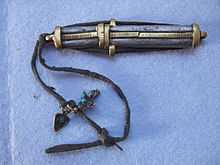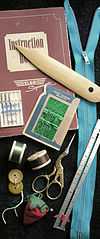Sewing needle
.jpg)



A sewing needle is a long slender tool with a pointed tip. The first needles were made of bone or wood; modern ones are manufactured from high carbon steel wire, nickel- or 18K gold plated for corrosion resistance. The highest quality embroidery needles are plated with two-thirds platinum and one-thirds titanium alloy. Traditionally, needles have been kept in needle books or needle cases which have become an object of adornment.[1] Sewing needles can also be kept in an etui, a small box that held needles and other items such as scissors, pencils and tweezers.[2]
A needle for hand sewing has a hole, called the eye at the blunt end to carry thread or cord through the fabric after the pointed end pierces it.
Types of hand sewing needles
Hand sewing needles come in a variety of types/ classes designed according to their intended use and in a variety of sizes within each type.[3]
- Sharp Needles: used for general hand sewing; built with a sharp point, a round eye, and are of medium length. Those with a double-eyes are able to carry two strands of thread while minimizing fabric friction.
- Appliqué: These are considered another all-purpose needle for sewing, appliqué, and patch work.
- Embroidery: Also known as crewel needles; identical to sharps but have a longer eye to enable easier threading of multiple embroidery threads and thicker yarns.
- Betweens or Quilting: These needles are shorter than sharps, with a small rounded eye and are used for making fine stitches on heavy fabrics such as in tailoring, quilt making and other detailed handwork; note that some manufacturers also distinguish between quilting needles and quilting between needles, the latter being slightly shorter and narrower than the former.
- Milliners: A class of needles generally longer than sharps, useful for basting and pleating, normally used in millinery work.
- Easy- or Self-threading: Also called calyxeyed sharps, side threading, and spiral eye needles, these needles have an open slot into which a thread may easily be guided rather than the usual closed eye design.
- Beading: These needles are very fine, with a narrow eye to enable them to fit through the centre of beads and sequins along with a long shaft to thread and hold a number of beads at a time.
- Bodkin: Also called ballpoints, this is a long, thick needle with a ballpoint end and a large, elongated eye. They can be flat or round and are generally used for threading elastic, ribbon or tape through casings and lace openings.
- Chenille: These are similar to tapestry needles but with large, long eyes and a very sharp point to penetrate closely woven fabrics. Useful for ribbon embroidery.
- Darning: Sometimes called finishing needles, these are designed with a blunt tip and large eye making them similar to tapestry needles but longer; yarn darners are the heaviest sub-variety.
- Doll: Not designed for hand sewing at all, these needles are made long and thin and are used for soft sculpturing on dolls, particularly facial details.
- Leather: Also known as glovers and as wedge needles, these have a triangular point designed to pierce leather without tearing it; often used on leather-like materials such as vinyl and plastic.
- Sailmaker: Similar to leather needles, but the triangular point extends further up the shaft; designed for sewing thick canvas or heavy leather.
- Tapestry: The large eye on these needles lets them to carry a heavier weight yarn than other needles, and their blunt tip—usually bent at a slight angle from the rest of the needle—allows them to pass through loosely woven fabric such as embroidery canvas or even-weave material without catching or tearing it; comes in a double-eyed version for use on a mounted frame and with two colors of thread.
- Tatting: These are built long with an even thickness for their entire length, including at the eye, to enable thread to be pulled through the double stitches used in tatting.
- Upholstery: These needles are heavy, long needles that may be straight or curved and are used for sewing heavy fabrics, upholstery work, tufting and for tying quilts; the curved variety is practical for difficult situations on furniture where a straight needle will not work Heavy duty 12" needles are used for repairing mattresses. Straight sizes: 3"-12" long, curved: 1.5"-6" long.
Needles in archaeology

A variety of archaeological finds illustrate sewing has been present for thousands of years. The earliest bone needle dates to 61,000 BC and was discovered in Sibudu Cave, South Africa.[4] The Romans left elaborate traces of their sewing technology, especially thimbles and needles. Even earlier Stone Age finds, such as the excavations on the island of Öland at Alby, Sweden, reveal objects such as bone needle cases dating to 60,000 BC. Ivory needles were also found dated to 30,000 years ago at the Kostenki site in Russia.[5] A bone needle, dated to Aurignacian, was discovered in Potok Cave (Slovene: Potočka zijalka) in the Eastern Karavanke, Slovenia.[6] Native Americans were known to use sewing needles from natural sources. One such source, the agave plant, provided both the needle and the "thread." The agave leaf would be soaked for an extended period of time, leaving a pulp, long, stringy fibers and a sharp tip connecting the ends of the fibers. The "needle" is essentially what was the tip end of the leaf. Once the fibers dried, the fibers and "needle" could then be used to sew together skins and other items used in a cloth-like manner.
See also
| Wikimedia Commons has media related to Sewing needles. |
Notes
- ↑ "Antique Sewing Needle Cases". Collectors Weekly. Retrieved 2012-05-25.
- ↑ "Antique Sewing Needle Cases". Collectors Weekly. Retrieved 2012-05-25.
- ↑ http://www.sewing.org/files/guidelines/22_110_hand_sewing_needle_guide.pdf
- ↑ Backwell L, d'Errico F, Wadley L.(2008). Middle Stone Age bone tools from the Howiesons Poort layers, Sibudu Cave, South Africa. Journal of Archaeological Science, 35:1566-1580. doi:10.1016/j.jas.2007.11.006
- ↑ Hoffecker, J., Scott, J., Excavations In Eastern Europe Reveal Ancient Human Lifestyles, University of Colorado at Boulder News Archive, March 21, 2002
- ↑ Odar, Boštjan (2008). "A Dufour Bladelet from Potočka zijalka (Slovenia)". Arheološki vestnik 59: 13.
| ||||||||||||||||||||||||||||||||||||||
